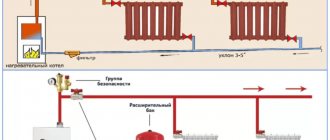You can heat a private house with solid or liquid fuel boilers, as well as with electric and gas heating equipment. Operating boilers of the first type is a rather troublesome and expensive task, because you constantly need to bring in fuel, load it into the working chamber of the boiler, and clean the chimney and boiler from ash.
Electric boilers and water heaters are easy to maintain, but consume a lot of electricity, so the home owner will have to pay considerable utility bills every month.
The most economical option is to use gas heating, because blue fuel is an inexpensive energy resource and after connecting the house to the gas main, the owner will only need to follow safety rules and carry out timely maintenance of gas appliances. This article will tell readers how to supply gas to a private home and what documents are required to collect to obtain a gasification permit.
Which houses can be connected to gas supply?
Centralized gas supply provides for the transportation and delivery of natural gas to the consumer. Connecting a permanent structure to the gas main includes two stages - organizational and technical actions. The set of organizational measures includes the preparation and collection of the necessary technical documentation, filing an application for gasification and concluding an agreement in the event of a positive decision by the gas service.
Technical actions: connecting the gas main to the land plot, connecting the house to the gas distribution network, installing a gas meter and starting the gas.
Gasification of a residential building is clearly regulated by law. According to Government Decree No. 1314, gas connections are permitted to capital buildings. If residential, country or garden houses, as well as garages and utility buildings, have a strong connection to the ground, that is, they are installed on a foundation and registered as real estate, then there will be no problems with their connection. In any other case, gasification will be denied. An attempt to connect gas supply to non-capital construction projects is prohibited by law and, depending on the consequences, is punishable by a fine or criminal punishment. In an apartment building, gas is connected to the entire house. To connect permanent buildings located on the territory of garage cooperatives, gardening or holiday villages, an application for technological connection is submitted by the owner of the territory.
Gravity system
Gravitational - natural pull. The circulation of water along a given contour is carried out by a pulling device, the laws of physics. No connection to the electrical network or pump is required.
Boiler gravity heating is a frequent guest of dachas and country houses where power outages occur. However, in houses that use a boiler, it is possible to organize it to save electricity.
Proper wiring for natural circulation is necessary. If the installation is not correct, the heating will become non-functional.
The installation feature is an inclination that does not interfere with the rise of water from the in-pipe pressure. The boiler is installed below the radiators, the angle provides traction for raising the media and descending as it cools.
Gravity flow
Required Documentation
To consider an application for technological connection of a residential building to the gas distribution network at the gas distribution organization (GRO), you need to collect the following documentation:
- documents confirming the applicant’s ownership of the house and land;
- a document confirming the compliance of the technical conditions of the house with the gas distribution network (TU);
- copy of passport;
- diagram of the land plot and adjacent territory;
- calculation of planned gas consumption;
- gasification project.
The application also indicates the location of the house that needs to be connected to the gas main, the applicant’s passport details and postal address, email address or telephone number for contact. The application can be submitted in electronic format on the GRO website, sent by mail or at the document acceptance center of the gas distribution organization. For the unreliability of documents attached by the applicant in electronic format, the legislation provides for administrative liability. The address of the GRO can be found in local authorities or found on the Internet, indicating the name of the subject of the Russian Federation.
Stages of gasification at home
The Contractor reviews the application within three days from the date of receipt. If the applicant has not fulfilled all the requirements, he is notified that he must provide all missing information and documents within 20 days. Consideration of the application is suspended at this time.
Results
Free gasification of private houses in accordance with Federal Law No. 184 dated June 1, 2021 must be completed by 2030. Considering that applications for connection are already being accepted throughout Russia, you need to send your documents to the gas distribution department as quickly as possible, otherwise the deadline for gasification of your particular site may be pushed back very far, given the large number of applicants.
You may also be interested in: How to force the administration to make a road in a village.
Ownership documents
If you are not the sole owner of the land plot, then consent to gasification of all adult owners is required. Your rights and the rights of other owners can be represented by third parties under a power of attorney executed in a notary's office.
If your house is connected to the gas distribution network from a neighboring plot, the consent of the owner of the plot is required. However, power assignment is possible only if the neighboring building has been connected to the same gas distribution network for at least 5 years and there are no technical contraindications to connecting a new consumer.
A land plot diagram (situation plan) can be obtained free of charge from the local administration, as well as from the BTI and from cadastral engineers, however, you will have to pay for their services. The calculation of the planned gas consumption is compiled by the contractor’s employees (GRO). If it does not exceed 5 cubic meters. m. per hour, no document is required.
FAQ
Most often, citizens are interested in the question: is it possible to get a loan for gasification of a house?
Contact any bank and they will definitely select a profitable lending option. For example, Rosselkhozbank has developed a special program for lending to the population in rural areas for gasification purposes.
Is it possible to carry gas into SNT?
The law provides such an opportunity, but the decision on gas distribution via SNT must be made by the general meeting.
Technical conditions for gasification of a residential building
A request for technical specifications is also submitted to the gas distribution service. They cannot refuse to accept an application for the provision of technical specifications if gasification is permitted by law and the applicant has submitted all the required documents. The examination will be carried out within the established time frame.
The basis for refusal to issue a document on technical specifications may be the lack of possibility of technological connection. In this case, the contractor must notify the customer about the approximate timing of such an opportunity. If the contractor unreasonably refuses to issue the technical specifications document, the customer may file a claim in court to force the issuance of the necessary documents and compensation for damage caused by such refusal.
The technical specifications document indicates the following parameters:
- maximum gas flow (m3/hour);
- name of the property;
- timing of connecting the house to the gas distribution main;
- characteristics of the network at the connection point;
- validity period of the technical specifications.
The calculation takes into account the area of the house, as well as the technical characteristics of heating and water heating equipment. When developing specifications, the throughput of the gas main and the number of connection points are taken into account. The connection point is the place where the gas consumption network is connected to the gas main.
Connection point of the house to the central gas system
According to the established regulations, the house must be connected at one point. If there are two residential buildings on the site, it is possible to connect each house separately.
The technical specifications document is valid for 70 days, excluding weekends, unless the date of its validity is indicated. During this time, you need to have time to develop a gasification project and conclude a connection agreement. If you do not meet this time, you will have to re-conduct a technical examination and draw up a report.
Optimal gas heating scheme
You can rely on 2 diagrams related to the types of available heating devices. They are based on one operating principle: gas heats water to distribute and release heat throughout the entire area of the house. The choice is made based on the characteristics of residential meters.
Available heating schemes:
- Single-circuit gas boiler. It is characterized by a constant volume of coolant in the heating system.
- Double-circuit gas boiler. It has the additional ability to heat water for household use. To do this, a plate flow model of the heater or a storage version of the tank is used with the addition of its own burner and the ability to regulate power thanks to a thermostat. Therefore, such an implementation becomes not only part of the heating system. It increases the comfort of life in the home by providing warm water for washing dishes and taking a bath.
Gasification project
Project documentation is drawn up based on information about the specifications. The list of documents includes the following information:
- the place where the gas pipe enters a private house;
- distribution of communications throughout the facility and inside the house;
- list of necessary work when connecting;
- security measures;
- work estimates;
- recommendations on the technical characteristics of gas equipment.
Gasification project for a private house
To develop design documents, the designer takes the necessary measurements on site, taking into account the customer’s wishes regarding the location of gas appliances. The gasification project can be drawn up by specialists from the gas distribution company, but the law provides for the possibility of engaging third-party companies to develop the project, but their services will be more expensive. However, in this case the documentation will be compiled faster. When contacting a third-party design organization, you need to check that it has a license to carry out this work.
Previously, a project for gas distribution throughout the house was needed only for buildings of 3 floors or higher with 1 family living. However, according to SP 402.1325800.2018, from 06/06/2019, the gas supply project will become mandatory in other cases when connecting to gas.
Classification of gas boilers, main operational characteristics, recommendations for selection
Domestic gas boilers used for heating systems of private houses and apartments are divided according to the following criteria:
- Installation method;
- Power;
- Type of gas burner;
- Burner ignition method;
- Type of traction;
- Combustion chamber type;
- Number of circuits;
- Heat exchanger material.
Let us consider the characteristics of these parameters in more detail.
Installation method (location)
- Parapet . They have a small power of 5-15 kW and are used for heating apartments and small houses. Installed on the wall, or under windows. The chimney (coaxial) is discharged through a hole in the wall directly at the installation site;
- Wall mounted . The power range of wall-mounted gas boilers is 10-35(40) kW. They have small overall dimensions, some models have a stylish design that allows them to be installed in the kitchen without covering them with a false panel. Compact, the design includes all the necessary devices and control systems. They have wide functionality. Their use is quite acceptable for one- and two-story houses of small and medium size, subject to high-quality insulation;
- Floor-standing . They are characterized by high power, performance and wide functionality. A chimney pipe is required; in some cases, installation must be carried out in a special room.
Number of circuits
- Single-circuit devices, the sole purpose of which is to heat the heating fluid of the heating system;
- Double-circuit - in addition to heating, they heat water for the DHW system. There are flow-through or with a built-in boiler. The latter are more economical to operate, but have somewhat larger overall dimensions and cost. In summer, double-circuit boilers can operate exclusively in DHW mode.
Type of traction
Each type of boiler, (except electric), regardless of the type of fuel, needs oxygen for combustion. The method of its arrival is called draft.
Natural cravings . It implies the supply of air directly from the room in which the boiler is installed. Water vapor and combustion products are removed through a vertical chimney. The design of such boilers is somewhat simpler, and the cost is correspondingly lower. In addition, they have additional advantages: quiet operation, energy independence. However, such devices are sensitive to gas pressure. At low pressure, the burner flame may go inward, causing it to burn out.
Forced draft . The design of such a boiler includes fans that supply air to the closed combustion chamber. The exhaust of combustion products and the intake of air from outside the building is carried out through the same coaxial chimney. This design has its advantages:
- Air from the room is not used, so there is no need to create a ventilation system;
- There is no need to build an expensive vertical chimney;
- Stability of operation is ensured even with a significant decrease in pressure in the gas pipeline;
- The boiler can be installed in any room, there is no need to build a boiler room;
The disadvantages of a forced draft boiler are:
- Noisy operation – the sound from the fan is quite loud;
- High price;
- Energy dependence.
Fee for gas connection to a private house
After completing all legal formalities, the contractor sends an application to the executive body for tariff regulation to establish the cost of technological connection. In this case, the customer must be notified no later than 5 days from the date of sending the application. The application is accompanied by a connection agreement, a positive expert opinion of the estimate and design documents, estimate documentation indicating the cost of each type of work.
Having studied all the documentation, the executive authority, within 22 days, excluding weekends, approves the amount of payment for each type of work separately. If the applicant refuses to connect the household to the gas pipeline after concluding an agreement and conducting examinations, the owner of the household will compensate the contractor for all confirmed expenses.
Refilling the gas tank
The gas tank is filled through the filling valve using a special vehicle - a gas carrier (the tank capacity can be up to 55 m³), the process of filling the tank with gas is monitored by a level gauge, which indicates the degree of filling of the tank as a percentage.
The reservoir is filled to a level of 85% of the total volume, the remaining 15% of the container is intended to accommodate the gaseous phase, which is formed as a result of the evaporation of the liquid.
Rice. 21 Filling the gas tank with liquefied gas
When choosing the option of autonomous gas supply to a country house, many opt for underground tanks for storing liquefied gas - gas holders. At the same time, they will have to face not only the very high cost of the tank, but also the further costs of regular maintenance and technical inspections.
Installation of a gas pipeline to a private house
The connection fee obliges the contractor to bring the gas distribution network to the connection point and prepare the facility for gas start-up no later than the deadlines established by the contract. Distribution of communications around the site and inside the applicant’s house is paid separately. If this work is carried out by specialists from a gas distribution organization, then their cost will be calculated according to tariff rates. To save time for carrying out work within the boundaries of the site and inside a permanent structure, third-party companies can be hired. In this case, payment is calculated at market prices.
Installation of a meter when introducing gas into the house from outside
If a gas distribution network is laid to the border of the site, installation work to supply gas to a private house for citizens of the first category must begin no later than 9 months after payment for the technological connection. Connecting the house to the gas pipeline must be completed within 10 days from the start of work.
The final stage of installation work is installing the meter, connecting gas appliances, checking the system for possible leaks, checking ventilation and testing the gas. This work can only be carried out by GRO employees. After this, a certificate of readiness is signed, the owner of the house receives a technical inspection receipt, and the documents are again sent to the gas distribution organization. Within three weeks, city gas workers must come and seal the gas meter. Then a gas supply agreement is concluded with the consumer and the capital structure is included in the gas supply system. These relations are regulated by Government Decree No. 549.
Insertion into the central gas pipeline to connect a residential building
How it works?
A gas stove connected to a liquefied gas cylinder is a common occurrence. Using the same principle, you can supply blue fuel to a gas boiler to provide heating and hot water supply to the entire house. You just need a larger container or even several tanks of liquefied gas.
The fuel used in such systems is an analogue of natural gas, which consists of a mixture of butane and propane. This mixture is called LPG - liquefied petroleum gas.
Image gallery
Photo from
Gas holder for gasification of a country house
Reservoir for providing gas without connection to the mains
Easy to install and operate
Vessel for storing explosive substances
To organize an autonomous or alternative gas supply system at home, it is necessary to combine the following elements into a single system:
- LPG storage capacity - one or more;
- evaporator (pressure regulator) for gas;
- gas pipes;
- system controls;
- appliances that run on liquefied gas: stove, water heater, boiler, etc.
Special gas appliances are not needed for autonomous gas supply to a country house. If the boiler or water heater can operate from the main gas network, then a cylinder or gas holder can be connected to it. This is very convenient if in the future you plan to connect a centralized gas main to the house, you will not have to change the equipment.
Autonomous gas supply to a private home is usually carried out using a special container - a gas holder, from which liquefied gas is distributed through pipes (+)
The main reason why owners of private houses abandon electric and solid fuel boilers for heating in favor of gas units is the relatively low operating costs.
Gas, including liquefied gas, is cheaper than electricity or coal. The difference even covers the cost of installing an autonomous gas supply system.
Another advantage of liquefied gas boilers is the high degree of equipment automation. If the operation of gas-consuming appliances is configured correctly, they will turn on and off automatically, heating the coolant and/or hot water to the set temperature.
This is convenient and also allows you to optimize gas consumption. If all safety measures are followed, liquefied gas can be stored for a very long time, taking only the required amount. You can refill the gas tank or cylinders only once or twice a year.
Benefits and subsidies for gas supply to a private home
According to Federal Law No. 69-FZ (as amended on July 26, 2019), Article 24 approves a list of persons who can be provided with benefits and subsidies for connecting gas supplies to private households and supplying gas. These include the following categories of citizens:
- pensioners;
- disabled people of groups I, II, III;
- veterans, combatants and their widows;
- large families;
- liquidators of the Chernobyl accident;
- low-income families.
The amount of benefits is regulated at the federal and regional levels. In most cases, a 50% discount on gas connections is provided to owners of private houses belonging to these categories of citizens. However, regional authorities of individual constituent entities of the Russian Federation can return up to 90% of the connection cost. Veterans and disabled people of the Second World War, survivors of the siege, as well as persons over 80 years of age, can be provided with 100% compensation.
Payments for gas connection to the house to benefit groups
To apply for compensation, you need to contact the social insurance fund at your place of registration. You need to have with you:
- Passport.
- Documents confirming ownership of a capital structure.
- Pension certificate (for pensioners).
- Medical documents confirming disability (for disabled people of groups I, II, III).
- Certificate of family composition.
- Certificate of income (for low-income citizens).
- Agreement with a gas distribution organization and a gas supply agreement.
- Acts of completed work.
- Payment receipts (to confirm the purchase of gas equipment and gas supply connection).
If false information is provided, there is a debt, missing documents or an incorrectly completed application, compensation will be denied. Working pensioners may also be denied a subsidy. According to the law, preferential categories of citizens are required to confirm their status annually.
In conclusion of the article, it is worth noting that the ease of use and low cost of blue fuel will pay for the troublesome and expensive gasification procedure.











